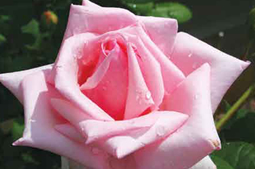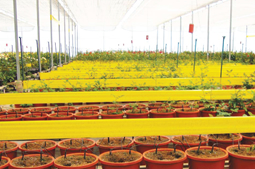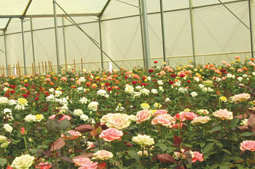Featured Past Articles
 Irrigation in greenhouses can be a major challenge for some managers because water supply and water quality can considerably affect the success of the crop. However, regular water analysis is not always a common practice in many greenhouses.
Irrigation in greenhouses can be a major challenge for some managers because water supply and water quality can considerably affect the success of the crop. However, regular water analysis is not always a common practice in many greenhouses.
Considering that water may be coming from many sources throughout the year, there can be variability in quality. That’s why it is important to look in a water analysis.
The water provided by rivers, dams and boreholes can have variable chemistry throughout the year. Why is this important? Water quality can impact a growing medium’s pH because of high or low water alkalinity.
Therefore, a periodic water sampling and analysis program will keep tabs on the minerals or nutrients present in the water and which can affect a growing medium’s pH and fertilizer availability for plants.
Wilting Under New Rules, Competition
With a perfect allyear growing climate, affordable labor and access to temperature-controlled air freight, Kenya has all the ingredients to become one of the top flower producers in the world.
 Hopes by Kenya’s flower growers to exploit the lucrative United States market and stop dependence on the European market has not borne much fruit despite the recent launch of direct flights between Nairobi and New York.
Hopes by Kenya’s flower growers to exploit the lucrative United States market and stop dependence on the European market has not borne much fruit despite the recent launch of direct flights between Nairobi and New York.
In spite of optimism and excitement after national carrier Kenya Airways (KQ) started direct flights to the US, the airline’s business strategy of focusing on passengers as opposed to cargo has dashed the hopes of the flower industry of targeting the market that has remained elusive.
This is bad news for the industry which despite being the second leading foreign exchange earner after tea, is grappling with a myriad of challenges that are threatening the country’s position as Africa’s leading producer of cut flowers.
The story of the world’s trading networks told through eight everyday products.
 For more than 200 years, the heart of the global trade in cut flowers has been the Netherlands. The world’s largest global auction for flowers began, famously, in a pub. One trader turned to his peers and asked, how much?
For more than 200 years, the heart of the global trade in cut flowers has been the Netherlands. The world’s largest global auction for flowers began, famously, in a pub. One trader turned to his peers and asked, how much?
The question was the start of the most dynamic and highly organised trading sites for flowers in the world. Now known as the Royal FloraHolland auction house at Aalsmeer, near Amsterdam, the floor of a cavernous warehouse is home to a giant game of Tetris with living flower stems bustled about on trolleys, to be bought, sold and dispatched.
As it has done for years, Royal Flora Holland still plays a critical role importing and then re-exporting 40% of flowers from all over the world. But newer players in the flower trade are making their presence felt, shifting the dynamics of production. As transport technology develops, producers in regions elsewhere, including sub-Saharan Africa, are challenging the Netherlands’ traditional hold on the industry.
 Ask any coach and He will tell you that when his fate depends on competitors’ match, the situation is out of control. So, it is with Kenya’s flower sector as our fate in the flower sector is determined by others. The truth is, we are in a catch 22 situation. This is the time for Kenya to think outside the Box and redeem its flower and export sector.
Ask any coach and He will tell you that when his fate depends on competitors’ match, the situation is out of control. So, it is with Kenya’s flower sector as our fate in the flower sector is determined by others. The truth is, we are in a catch 22 situation. This is the time for Kenya to think outside the Box and redeem its flower and export sector.
Flower farms push for special zones Flower producers want the enterprises granted Special Economic Zones (SEZ) status to cushion them against runaway costs that are fast eroding competitiveness in the export markets. Kenya Flower Council chief executive Clement Tulezi said while the SEZ Act was assented to in September, 2015, and came into effect on December 15, 2015, regulations to operationalise it were yet to be gazetted.
“We deal in export-bound only products that warrants us to enjoy SEZ status. New regulations will create licensing processes and state fees applicable while enabling flower enterprises to enjoy tax benefits that come with this authorised economic operator special status,” he said. Mr Tulezi said SEZ the status will help ease challenges attributed to new punitive regulations on control of plastics and double inspection of imported fertilisers.
Concisely describe Hannah Kibiru  Kibiru is a Dedicated, self-motivated, enthusiastic and strategic thinking professional with 10 years’ experience in the Agriculture sector as an Agronomist. Well versed in all phases of horticultural crop production, specifically in floriculture and Olericulture, People management, production and sustainable use of conventional crop protection agents in harmony with the Bio- control agents. Experienced in managing projects from requirements gathering/ needs identification phase all through to completion.
Kibiru is a Dedicated, self-motivated, enthusiastic and strategic thinking professional with 10 years’ experience in the Agriculture sector as an Agronomist. Well versed in all phases of horticultural crop production, specifically in floriculture and Olericulture, People management, production and sustainable use of conventional crop protection agents in harmony with the Bio- control agents. Experienced in managing projects from requirements gathering/ needs identification phase all through to completion.
What spurred you into Agriculture? Any role model who inspired you?
As a young lady growing up in a third world country, I saw people daily suffering and struggling to meet the basic nutritional requirements. I felt I would make significant impact on many individuals by taking agriculture as a career and profession. By participating in this sector am sure of not only earning a living but also technically giving back to the society.
 The Global Biopesticides Market was valued at USD 3147.1 million in 2018 and is expected to register a CAGR of 14.1% during the forecast period (2019-2024). Of all the regions, South America is expected to witness the fastest growth in the forecast period, recording a CAGR of 16.4%. In addition, the United States is likely to be the largest individual market over the forecast period.
The Global Biopesticides Market was valued at USD 3147.1 million in 2018 and is expected to register a CAGR of 14.1% during the forecast period (2019-2024). Of all the regions, South America is expected to witness the fastest growth in the forecast period, recording a CAGR of 16.4%. In addition, the United States is likely to be the largest individual market over the forecast period.
While the prevalence of chemical or synthetic pesticides in crop protection continues; human, animal, and environmental health concerns are still playing key roles in driving the growth of biopesticides. Several countries are adopting a stringent approach concerning the amount of imports, with a special focus on regulating the quantity of pesticide residues. Emerging economies in Asia-Pacific are likely to take the lead in the adoption of biopesticides.
Biopesticides are certain types of pesticides, derived from natural materials as; animals, plants, bacteria, and certain minerals. It is important to take into consideration both microbial and organic pesticides. The market is broadly segmented into bioinsecticide, bioherbicide, biofungicide, and others. This presents a wideranging analysis of market share, size, and volume of the biopesticide market on a global scale.
Authenticated Solutions for Agriculture in the whirlpool of large and niche market
 The Agriculture Industry, which is the backbone of our economy, is facing multiple threats from the growth of fake pesticides. According to a latest study conducted, the fake pesticides industry in India was estimated at billions of US dollars globaly, which account for 25 per cent by value and 30 per cent by volume of the domestic pesticides industry . The Study indicates that this market is expected to grow at the rate of 20 per cent per annum in terms of value, and if not addressed, can reach to approximately 40 per cent share by value in the pesticides industry by 2019. The problem is extreme in many countries including Kenya.
The Agriculture Industry, which is the backbone of our economy, is facing multiple threats from the growth of fake pesticides. According to a latest study conducted, the fake pesticides industry in India was estimated at billions of US dollars globaly, which account for 25 per cent by value and 30 per cent by volume of the domestic pesticides industry . The Study indicates that this market is expected to grow at the rate of 20 per cent per annum in terms of value, and if not addressed, can reach to approximately 40 per cent share by value in the pesticides industry by 2019. The problem is extreme in many countries including Kenya.
Consequences of Counterfeit pesticides:
The Contribution of agriculture sector in the GDP is already declining. This trend is worrying and will create a natural stretch on the agriculture sector in the future.
The growth of spurious is adding fuel to the fire as Kenya has suffered a loss of tons of food grain production. In light of this, Kenya’s position as food sufficient country and exporter in the world is also at stake. There is no denying that the damage through such products is multi-fold and the counterfeit pesticides pose a significant threat to various stakeholders


